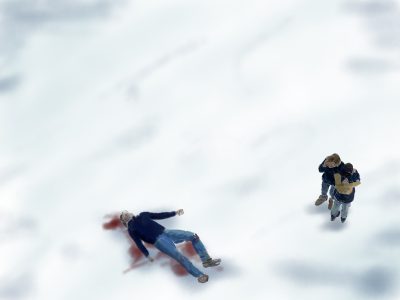
Before “Anatomy of a Fall” begins, a URL flashes on the screen for a brief moment: didshedoit.com. On the site, visitors are presented with a yes or no poll, asking the audience whether they believe the film’s main character is responsible for the film’s crime.
This simple introduction doesn’t give the audience many details, but it tells us one thing — we will not be able to discern responsibility by the content of the film alone.
Viewers need to scrutinize every moment of “Anatomy of a Fall” because the film is not going to uncover the truth for them.
The film opens with the spirit of a whodunnit — a well-known writer’s husband plummets to a mysterious death from the attic of their rural home shortly after the departure of an unusual guest, and his body is discovered by their visually impaired son.
An investigation is launched to uncover the nature of his death, and the majority of the runtime focuses on the trial of writer Sandra Voyter (Sandra Hüller) for the suspected murder of her husband, Samuel (Samuel Theis).
As the trial unfurls, the film itself becomes a clinical investigation of our own scrutiny. The tight, vérité-style structure of the film allows the audience to become acutely aware of their status as spectators. And like cinema vérité, the film takes a solely observational role in the telling of the story, giving the audience no more information than the jurors.
As voyeurs, we are limited to the subjectivity of the prosecutors and defendants, presented with ambiguous images through which it is impossible to identify a singular explanation.
While the trial feels like an attempt to bring clarity to an unknown situation, the flimsiness of our certainty becomes apparent as we are presented with more and more nuance. The trial moves beyond examining the evidence of the incident, digging deep into the lives of Sandra and Samuel and subjecting the personal details of their private life to endless scrutiny and ridicule.
But as more evidence is revealed, the case becomes cloudier, and the mediation of a courtroom does not account for the complexities of human interaction. A procedural analysis of personal failings and the hurdles of everyday life cannot delineate between good and bad because both exist at the same time.
As the trial continues, the testimony is punctuated by long shots of the audience, frozen in shock, disgust or thought. These steady shots give the viewer a distinct awareness of how we process what we are seeing, contrasting the wandering cinematography of the courtroom.
Because the film echoes the structure of an inquisitive law system, we are nudged into the role of a scrutinizing observer, only to make us uncomfortably aware of our judgment.
We seek a clear answer but our ability to discern it is limited to a system that is blind to the fluidity of the human condition.
In our attempt to find justice, we as an audience descend into a trap.
The delineation of good and bad is a construct of our own scrutiny, as these concepts only exist in relation to the other.
The legal process necessitates delineating black and white from a field of gray, and so we grasp at straws to create the narrative we want, scrutinizing the nuances of reality in an attempt to shape an easy answer.
A fall can be many things — a rapid descent, a loss of balance, a defeat.
In “Anatomy of a Fall,” it is all of them — a fatal tumble from a rooftop, the destruction of a writer’s public image, a child’s loss of innocence, a failure to balance a multitude of truths.
Reality, mundane or extraordinary, can almost never be clear cut. But a clinical dissection of a human event in order to seek a black-and-white answer won’t ever capture the extent of the truth — it will simply shape a narrative.
Intense scrutiny does not uncover monsters — it creates them.



